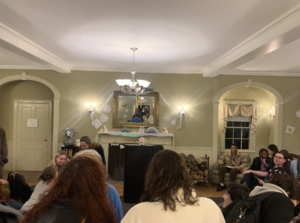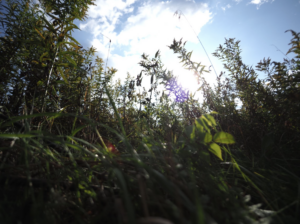Jean Toomer’s Cane, when first read, is an elusive novel; he leans into vignettes, poetry, and drama, stringing together a unique fragmentation of the black experience in Jazz Age America. Divided into three parts, it chants and rings across the page with dexterity, demanding the reader to feel its energy in entirety, as though it is alive itself, breathing, conscious, and undeniably timeless (Cane passed out of print briefly before its resurrection in 1967.) However, in many ways, the piece defies interpretation; its genre-bending anatomy and hypnotic prose coerce the reader to look in many directions, to ruminate over its diverse cast of characters, poems, and ideas. To call it a novel would be reductive, and contrary to Toomer’s intentions, given his desire to avoid racial labeling and general compartmentalizing. The novel artfully investigates individualism using this aesthetics palette as a form of reclaiming the South artistically for blackness in a meditation of the way one’s identity, is impacted by experience and crafted from this space even in an environment of hegemony
The novel is structured so as to contain prose in vignette form alongside poetry and drama infusions, with the capstone on the project being “Kabnis” (which is more novella, perhaps, as it occupies nearly fifty pages of the project as a whole.)
Toomer employs poetic elements liberally throughout the book, allowing the work to become sensuous, hypnotic, and incantatory; it is through this poetry that we begin to understand his desire to revitalize the South artistically. He uses familiar Southern imagery—including references to tobacco, cane, plantations, farms, etc.—with a modern Gothic twist.
For instance, in the story “Esther,” which is set in Georgia, the title character dreams of a fire triggered by the setting sun in two separate environments. Her first dream portrays the fire department ruthlessly shoving onlookers aside as it “rushes madly” down the road. They put out the fire, and save a baby, whom Esther takes possession of; she thinks of it “immaculately,” yet this is sinful to her. The dream shifts, the fire scorches, there is no fire department, and the onlookers circle the heap of flames spurting tobacco juice from their mouths and into the open flames. “The air reeks with tobacco juice,” and another baby is born from the flames; this time, it is a “Black, singed, woolly, tobacco-juice baby–ugly as sin.” Esther loves it immediately, and desperately (Toomer 30).
The poetry of this passage permeates the narrative with profound intensity beyond the artifice of imagery. Toomer takes advantage of Southern iconography in many ways, although he utilizes tobacco most significantly. To have onlookers chewing it, spitting it into the flames, Toomer is able to construct a timeless space that reaches physicalization in the dream; tobacco was a cash crop and a staple in the Southern economy during the early colonization of America, yet the use of chew is strikingly modern in this sense, as we begin to imagine the gas station owners sitting outside on porches, chewing away to sip the breeze from the air, scratching their chest through overalls. Or, perhaps, one thinks of a farmer, a brother, a sister, mother, father, someone close and dear, with stories as wide as the very fields; Toomer’s image here works in many ways, to penetrate the reader’s conscious to stir very specific and deliberate images that are at times purely Southern (or contain the kiss of the South.) But when this tobacco juice enters the fire, scorching the air, it becomes a physical body through the baby.
The baby itself is described as soot-black, and “ugly as sin” (the reference to sin conjures up a Devil All the Time-Esque religious groundwork associated with the South, which is an integral choice that Toomer makes in constructing the child.) Esther loves the baby anyways, much more than the immaculate one; paradoxically, as well, the immaculate baby is itself sin, as Esther drives thoughts of its purity from her mind. The baby is quite literally a construction, an alchemical body crafted from the fire and what went into it; its anatomy consists of the tobacco juice, it is singed, burnt, ugly, woolly, and yet cherished, while others look on with envy.
The seemingly contradictory occurrences in these children are essential to understanding the novel and its complexities. The second baby, quite literally, is a construction of the South, as it embodies a religious and cultural iconography. Rather than being refused, it is cherished, despite its ugliness, blackness, and sinfulness. Toomer strips away illusions surrounding white Southern ideals, prying away its capitalistic history, its white supremacy, its Jim Crow embodiment, and instead reaches within the very fires of this cruelty to show us the result; a nuanced, powerful child, with an identity of his own, crafted from the dreams and pains of living, a walking embodiment of the blues as an artistic force, shrouded in Southern aesthetics and the core ideas behind the Harlem Renaissance.
“Kabnis” behaves in an extremely similar fashion, however, the stakes are higher as the dream Esther has gets injected into reality through Kabnis’s perception and experiences within the story. The novella opens with Ralph Kabnis, a black Northerner visiting Georgia to teach. He is struggling to sleep, restlessly trying to force himself into exhaustion. But the wind whispered through the cracks in his floorboards, as though the wood were “lips the night winds use for whispering. Night winds in Georgia are vagrant poets, whispering.” This sensation reaches beyond a metaphor as the whispers take a song-like quality:
White-man’s land…
Burn, bear black children
Till poor rivers bring
Rest, and sweet glory
In Camp Ground.
As he embodies this incredibly vulnerable state of mind, reality itself distorts around him; “Ralph Kabnis is a dream,” he says to himself, “And dreams are faces with large eyes and weak chins…If I, the dream (not what is weak and afraid in me) could become the face of the South.” He looks through that singing crack and sees the “Dust of slave-fields, dried, scattered,” until he forces himself back into reality, lamenting his fitfulness, wishing for a drink (Toomer 109-110).
There is a tremendous disassociation occurring in this opening that sets up the rest of the novella to progress. As Kabnis struggles to sleep, he himself gets caught in his own meditations, slipping into a new level of consciousness where he sees himself as either a dream or a reality depending on the mask that he bears at a particular point in time. He feels himself to be weak, afraid, barely existing; he is in a psychological limbo, trapped between these metaphysical masks. It reaches a point where he notes how different he would be if, in fact, he was not weak or afraid; he would bear the “face of the South.” This is especially revealing; it comes from a place of pure vulnerability, driven by Kabnis’s sleepy detachment; if he were to push through insecurity, he would embody something of the South, the face of that land which he feels so alienated. He shutters at the wind and yet they hypnotize him; he lingers on the dust itself, sees the spirits of the past, sees the dust from the slave fields dragged in by enslaved black people, and the haunting song he hears embodies his fears as a black man in the South. He is profoundly alienated, shaken by the South’s racial violence, and himself trapped in this fear and seeing it as a weakness. Thus, through the employment of Southern imagery, Toomer poetically outlines Kabnis’s identity crisis; he is confronted by that specific heritage, by the pain it holds, the erasure and trauma it embodies and is threatened, driven into limbo, ghostlike, alone.
Eventually, the trauma reaches its zenith when he himself intercepts racial threats. When visiting some acquaintances, a rock is thrown through a nearby window, on which sits the message “You northern [N-Word], its time fer y t leave,” after hearing about a brutal lynching of a pregnant black woman by a white mob. Kabnis is absolutely terrified; everything he has feared regarding the South, that violence and trauma, collapses as it becomes actualized, and he flees back to his cottage.
He is not fully intact, however; he is described as a “splotchy figure,” a “scarecrow replica” of himself. In his distress, he drinks heavily before being caught by his boss, who fires him as a result of a religious distaste for alcohol, since he sees it as an indicator of a black person’s moral failure. Kabnis takes his punishment and continues to drink (Toomer 122-127.) Kabnis, completely changed, uninhibited, creates a new (although bitter) life in Georgia, and during a party, he laments in monologic fashion his condition: “Th whole world is a conspiracy t sin, especially in America, an against me. I’m th victim of their sin. I’m what sin is” (Toomer 157).
Kabnis undergoes an immense identity change in this portion of the book. In the beginning, he feels the whispers of an encroaching truth as the wind literally whispers these musings out to him through poetic realism; now, Kabnis experiences it entirely. The trauma of hearing the lynching story, combined with the very deliberate threat hurled at him through the window (whether it was directed towards him or not is speculation, yet that is irrelevant given his reaction,) pushes him into a state of non-existence. His body takes the form of a lifeless, straw-filled creature, and he leaves his job; he is now a blank slate, as his identity crisis at the beginning of the story, as marked by his distortion of reality and dreams, becomes actualized. All of his masks fall away, and Kabnis is now an embodiment of nothingness as a result of the racial trauma he has experienced. Nonetheless, time passes, and he recognizes how the world itself has damned him. He reflects on the idea of sin and its futility, the way in which he sees sin throughout the world, and yet he is made of sin. He is condemned because he is a black man, and thus whiteness subscribes to a racial sin unto him, which is manifested by the Jim Crow threats and trauma, and he is in this case a victim of the world’s sin. And yet, he is made of sin; he realizes that a part of his identity is connected to this trauma, the way in which that narrative contributes to who he is.
He is so deeply dehumanized that he is forced to realize that, with all the pain and joy he has experienced as a black man, in Jim Crow America, this is who he is; he is sin, he is a victim of sin, he is pain, he is a victim of that pain. He is able to reach into himself and from there pull at the disarray he feels in Georgia, and use it to fuel himself. He has suffered, and yet he understands himself. He sheds fear and most importantly he sheds notions of social constructs (which is embodied in his treatment of sin, which crosses the barriers of morality in ways that subvert those same divisions.) Thus, Kabnis uses the pain and joys of his experiences, the fear and conviction, all within the vessel of Southern imagery and his connection to that very landscape to defy the institutionalized notions of the “masks” surrounding him so as to make his own; he constructs his own identity from the raw material of Southern Aesthetics.
Toomer’s novel, although elusive, is designed to behave under the radar to defy interpretation, an exercise that masterfully reveals profound ideas regarding racial identity. As he employs Southern imagery through immense poeticism, he is able to dredge up Southern culture from a place of hate and trauma to intellectual beauty based on his experiences and observations as a black man. From the deepest place of pain comes a new and incredibly human revolution in art (just like jazz, it is a creation of the black experience, that touches the larger population in ways that cross-racial barriers through the immense suffering that fuels the culture alongside the joys of living.) It reworks society in this way, challenging social barriers for the sake of self-constructing one’s own identity as a subversion of oppression. Toomer shows us the raw material of our souls, and from a place of immense pain, he reclaims an entire aesthetic, showing us the ways in which this subversion can be employed to identity. Cane embodies not only the mission behind the Harlem Renaissance, but also that of Modernism as a whole; beyond these scopes, his novel is a timeless testament to individualism, a champion of identity, and a poetic subversion of oppressive forces.

Dylan Walawender is a first-year student studying literature and creative writing, with a little bit of philosophy and psychology worked in there. He enjoys reading, writing, and nature stuff like hiking, finding plants, things of that alignment.
Book Reviewer, Cultural Examination Columnist, Website Team Member, Journalistic Education Team Member













Really informative article.Really looking forward to read more. Really Cool.
Top Gaming Chair